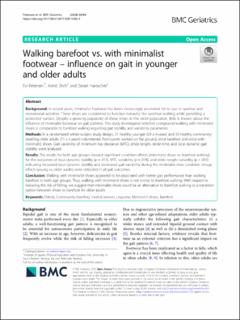| dc.contributor.author | Petersen, Evi | |
| dc.contributor.author | Hamacher, Daniel | |
| dc.contributor.author | Zech, Astrid | |
| dc.date.accessioned | 2020-06-03T12:53:07Z | |
| dc.date.available | 2020-06-03T12:53:07Z | |
| dc.date.created | 2020-04-25T23:36:21Z | |
| dc.date.issued | 2020 | |
| dc.identifier.citation | Petersen, E., Zech, A., & Hamacher, D. (2020). Walking barefoot vs. with minimalist footwear - influence on gait in younger and older adults. BMC geriatrics, 20(1), 88. doi:10.1186/s12877-020-1486-3 | en_US |
| dc.identifier.issn | 1471-2318 | |
| dc.identifier.uri | https://hdl.handle.net/11250/2656401 | |
| dc.description.abstract | Background: In recent years, minimalist footwear has been increasingly promoted for its use in sportive and recreational activities. These shoes are considered to function naturally like barefoot walking while providing a protective surface. Despite a growing popularity of these shoes in the older population, little is known about the influence of minimalist footwear on gait patterns. This study investigated whether overground walking with minimalist shoes is comparable to barefoot walking regarding gait stability and variability parameters.
Methods: In a randomized within-subject study design, 31 healthy younger (29 ± 4 years) and 33 healthy communitydwelling older adults (71 ± 4 years) volunteered. Participants walked on flat ground, once barefoot and once with minimalist shoes. Gait variability of minimum toe clearance (MTC), stride length, stride time, and local dynamic gait stability were analysed.
Results: The results for both age groups showed significant condition effects (minimalist shoes vs. barefoot walking) for the outcomes of local dynamic stability (p = .013), MTC variability (p = .018), and stride length variability (p < .001) indicating increased local dynamic stability and decreased gait variability during the minimalist shoe condition. Group effects (young vs. older adults) were detected in all gait outcomes.
Conclusion: Walking with minimalist shoes appeared to be associated with better gait performance than walking barefoot in both age groups. Thus, walking with minimalist shoes is not similar to barefoot walking. With respect to reducing the risk of falling, we suggest that minimalist shoes could be an alternative to barefoot walking or a transition option between shoes to barefoot for older adults. | en_US |
| dc.language.iso | eng | en_US |
| dc.rights | Navngivelse 4.0 Internasjonal | * |
| dc.rights.uri | http://creativecommons.org/licenses/by/4.0/deed.no | * |
| dc.title | Walking barefoot vs. with minimalist footwear–influence on gait in younger and older adults | en_US |
| dc.type | Peer reviewed | en_US |
| dc.type | Journal article | en_US |
| dc.description.version | publishedVersion | en_US |
| dc.rights.holder | The Author(s) | en_US |
| dc.source.journal | BMC Geriatrics | en_US |
| dc.identifier.doi | 10.1186/s12877-020-1486-3 | |
| dc.identifier.cristin | 1808056 | |
| cristin.ispublished | true | |
| cristin.fulltext | postprint | |
| cristin.qualitycode | 1 | |

